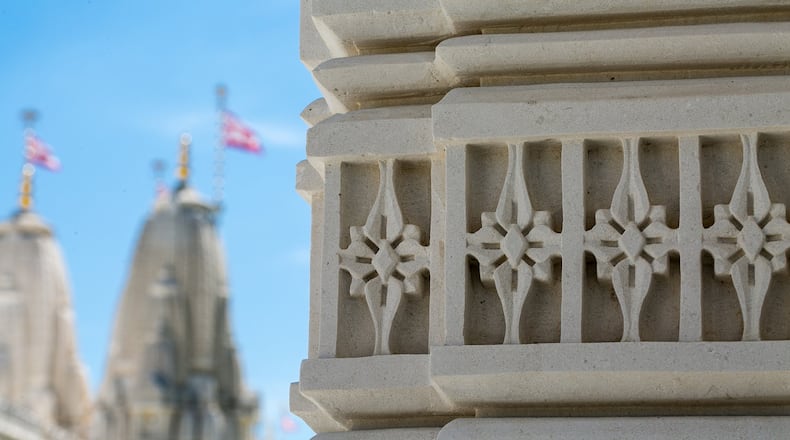The architecture of a city can often serve as a snapshot of its people. The shape, size and stories behind Atlanta’s buildings give our city distinction – from the grandiose eloquence of a shimmering skyscraper to the old-fashioned opulence of a gracefully aging mansion. Here’s a look – in no particular order – at some of our city’s most notable buildings you can visit.
Swan House
Having recently celebrated its 90th birthday, the sprawling Buckhead manse was the home of cotton broker heir Edward Inman and wife, Emily. Designed by neoclassical Georgia architect Philip Trammell Shutze, the gilded era landmark is considered by many to be his most successful residential and landscape design. For decades, locals have stood in awe of its double descending stairs, its Baroque-style lawns and stone fountains, as well as painted and sculpted swans adorning the interior. Preserved by the Atlanta History Center, tours of Swan House are available every day at 4 p.m. Cost is general admission ($9-$21.50) plus a $10 tour fee. 130 W. Paces Ferry Road NW, Atlanta. 404-814-4000, www.atlantahistorycenter.com.
Shri Swaminarayan Mandir
Offering a breathtaking architectural vision of Indian culture in Gwinnett County, the Shri Swaminarayan Mandir opened in 2007 on 30 acres and has since been visited by more than 2 million people. The largest Hindu temple in North America – and looking every bit of it – the structure’s spectacular features are numerous, but the Italian marble, Turkish limestone and towering spires with streaming flags are among its notable trademarks. When standing before something so regal, it’s second nature to pull out the phone for a selfie with friends, but be advised that photos are only allowed from the ground level outside of the Mandir. No photos or cell phone use, period, once inside. Also, a dress code requires visitors to cover shoulders and knees (wraps are provided), phones should be switched off and personal belongings such as backpacks should be left inside your vehicle.
Visiting hours 9 a.m.-6 p.m. daily. Free. 460 Rockbridge Road NW, Lilburn. 678-906-2277, atlanta.baps.org.
Center for Civil and Human Rights
The building’s curved exterior facades are said to resemble interlocking arms or cupped hands. Nestled inside is the center itself, which features three levels of exhibits and galleries and a studio dedicated to exploring the fundamental rights of all human beings. According to the architects’ website, “the concept of unity drove the design.” The end product was a distinctive building that explores difficult topics and aims to inspire conversations. According to the center’s website, it is hoped that visitors “leave inspired and empowered to join the ongoing dialogue about human rights in their communities.”
10 a.m.-5 p.m. Monday-Saturday; noon-5 p.m. Sunday (last entry at 4 p.m.). $15.99-$19.99. 100 Ivan Allen Jr. Blvd., Atlanta. 678-999-8990, www.civilandhumanrights.org
Buckhead Library
As far as local libraries go, one would be hard pressed to find something as architecturally interesting as this avant garde wonder in Buckhead Village. Built in 1989, the library has won many awards, including a National American Institute of Architects Award for Excellence. Belonging to what most would call a deconstructivist style, the building is covered with gray tiles and framed by exposed, metallic beams that rise and fall at often sharp angles.
10 a.m.-6 p.m. Monday, Tuesday, Friday and Saturday; 10 a.m.-8 p.m. Wednesday-Thursday. 269 Buckhead Ave. NE, Atlanta. 404-814-3500, afpls.org/buckhead-branch
Atlanta Marriott Marquis
While it’s not necessarily a destination — unless staying there — it’s hard to write a list of Atlanta architecture worth visiting without mentioning this one. Designed by Atlanta architect John C. Portman Jr. and completed in 1985, the building’s distinct atrium was once the world’s biggest. The Marquis remains our city’s largest hotel, and its aesthetic allure has attracted many, including movie crews for films like “Hunger Games” sequel “Catching Fire” and Denzel Washington’s “Flight.” Few hotels in the world can boast such a sweeping, scenic ride up the elevators. It’s a stunning view that all — Atlantans and beyond — should experience at least once.
265 Peachtree Center Ave., Atlanta. 404-521-0000, www.marriott.com/hotels/travel/atlmq-atlanta-marriott-marquis/
Polaris
What’s not to love about a blue-domed restaurant that spins ever so slowly as patrons within enjoy its 360-degree views of the Atlanta skyline, nibbling appetizers and sipping booze? Well, architecturally speaking, it’s a unusual sight to behold – inside and out. Another Portman creation (see above), Polaris resembles a friendly-looking flying saucer that landed atop the more than 50-year-old Hyatt Regency, revolving 22 floors above downtown. After a glass elevator ride to the top, guests can dine inside the space, which features modern and retro décor designed as a tribute to the restaurant’s history.
The “Castle on Peachtree” was built in 1904 of Stone Mountain granite in the Romanesque Revival style. Originally the residence of Rhodes Furniture founder Amos Rhodes the sprawling mansion now serves as a house museum and event venue. According to its website, the home was believed to have been inspired by Amos and wife, Amanda’s, travels through the German Rhineland in the 1890s. Of the many features within, visitors will find a series of painted glass windows above a carved mahogany staircase that depict the rise and fall of the Confederacy.
Museum hours 10 a.m.-2 p.m. Saturday. $7 for a behind-the-scenes tour of all three floors. 1516 Peachtree St., Atlanta. www.rhodeshall.org
Callanwolde Fine Arts Center
Before it was a visual and performing arts center, the 27,000-square-foot mansion in Druid Hills was once home to one of Atlanta’s most prominent families, the Candlers. Built between 1917 and 1921, the architecture is considered “a severe and modern approach to the late Gothic Revival style,” according to its website. The front façade features Tudor-Gothic design with a “uniquely 20th century approach …”
Self-guided tours are available from 9 a.m.-7 p.m. during the week. On weekends, call first to make sure the venue isn't being rented out. Donations accepted. 980 Briarcliff Road, Atlanta. 404-872-5338, callanwolde.org
Wren’s Nest
Visiting the Wren’s Nest offers the opportunity to see a Queen Anne-style Victorian up-close and learn the history of “Uncle Remus” series author and Atlanta Constitution journalist Joel Chandler Harris. The home – named for the birds that once nested in the mailbox – was Chandler’s residence from 1881 to 1908 and built originally as a farmhouse in 1870. It underwent substantial remodels when the Harrises bought it and, according to the Wren’s Nest website, offers “a unique example of upper middle class living at the turn of the 20th century.”
10 a.m. to 3 p.m. Saturday-Sunday, with storytelling at 1 p.m. every Saturday. $10; $8 for children, senior citizens and students. 1050 Ralph David Abernathy Blvd., Atlanta. 404-753-7735, wrensnest.org
About the Author
Keep Reading
The Latest
Featured











